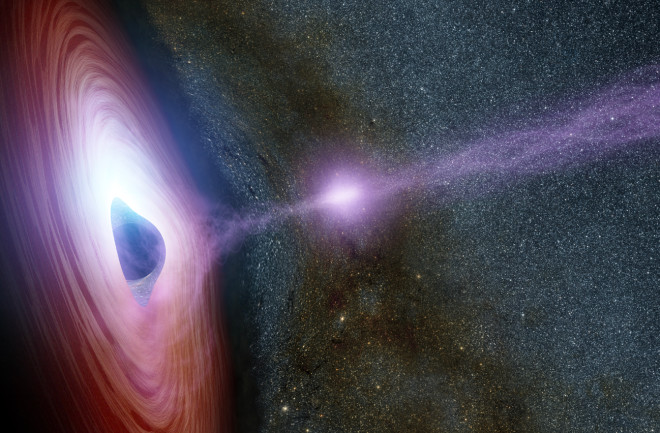Imagine a future in which humans have built advanced spacecraft, capable of traveling at a significant percentage of the speed of light. Scientists have also become aware of a large black hole in our galactic neighborhood — now well within our reach.
When a team of researchers assemble to travel to the black hole, one curious question might rise above all others: “What would happen if we flew straight into it?”
For now, this hypothetical scenario is still a long way off. Yet for as long as we have been aware of black holes, scientists have wondered what mysteries lie beyond the event horizon — the edge of a black hole, representing the “point of no return,” where even light is unable to escape the bizarre object’s gravitational pull.
Read More: Will Humans Ever Go Faster Than Light?
Black Hole Time Machine
Conventional wisdom, namely Einstein’s theory of general relativity (the best theory of gravity in town), predicts the presence of a singularity at the center of a black hole. It’s a point of infinite density that lies outside the bounds of our normal spacetime.
However, this prediction of a singularity does not necessarily mean it exists. Singularities tend to pop up at the very boundaries of our understanding — like inside black holes and at the Big Bang — and at the intersection of general relativity and quantum mechanics.
On the other hand, theorists working on a way to marry quantum mechanics with general relativity have suggested that something else might be going on at the center of black holes: Instead of forming a singularity, matter and energy may be sucked in and then spat out at some time in the distant future.
Yes, that's right, a time machine. Sort of.
All About Perspective: Loop Quantum Gravity
In their 2018 paper, researchers from Pennsylvania State University and Louisiana State University deploy the theory of loop quantum gravity. This theory posits that spacetime is quantized, meaning there is a smallest possible unit beyond which it cannot be divided further.
The researchers suggest that the strong curvature of spacetime near the center of a black hole extends into the future, which is structured like a white hole, or a blackhole in reverse. “Singularities are naturally resolved by the quantum geometry effects of loop quantum gravity,” write the authors.
From our perspective outside the black hole, matter and energy are continuously falling into it — because the spacetime around it is extremely distorted. But from the perspective of someone inside the black hole, matter and energy come in and bounce back out.
Keep in mind, however, that in terms of time relative to other events in the Universe, this bounce event may take billions or even trillions of years to occur.
Read More: This Is What a Black Hole Sounds Like
Inside a Black Hole
Whether a manned spacecraft could survive this bounce is a tough question. Any craft — and people onboard — would likely undergo a process known as spaghettification. Whilst crossing over the event horizon of the black hole, matter would be stretched flat like a long piece of spaghetti, possibly even to the point where it is just a long string of atoms.
It’s extremely unlikely that a spaceship (or human for that matter) would survive such an ordeal. And it's possible that the same thing would happen again on your way out — but in reverse.
For future scientists interested in the time-warping features of black holes, therefore, their best bet will be to stay in a relatively close orbit of a blackhole, taking advantage of its time-dilating properties from the outside.
Traveling Slower Through Time
One prediction of Einstein's general theory of relativity is that time will move slower the closer you are to an object of large mass. A strange consequence of this means that time moves slower if you are at sea level compared to on top of a mountain, as you are closer to Earth’s massive core at sea level.
Of course, in this example, the difference in the passing of time is negligible. But if you were instead on a spacecraft orbiting a large black hole, then the time-dilating effects would be significant indeed.
It’s possible that for every year you spent orbiting the black hole, for example, ten whole years may pass on Earth. Just be careful not to get too close to the event horizon.
Read More: What Is the Grandfather Paradox of Time Travel?

